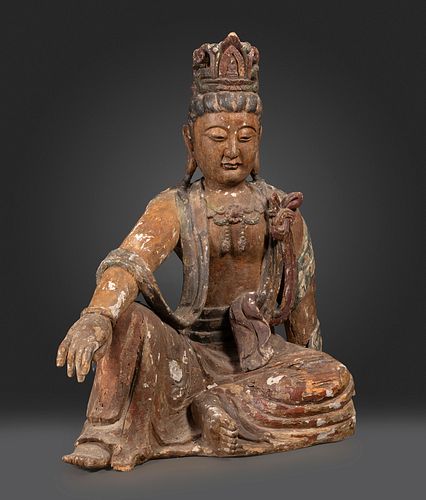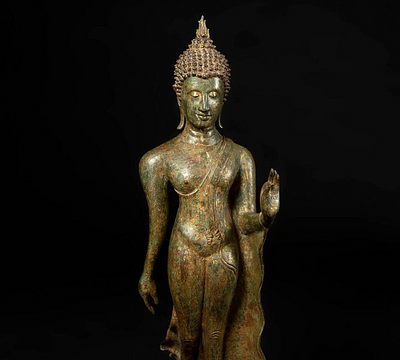Buddha. China, XVIII century. Polychrome wood carving.
Lot 48
About Seller
Setdart Auction House
Carrer Aragó 346
Barcelona
Spain
Setdart Subastas was born in 2004 and is currently the first online art auction in Spain with solidity, prestige and reliability guaranteed by our more than 60,000 users. Setdart has a young, dynamic and enterprising team ready to successfully manage the purchase and sale of art works through custom...Read more
Estimate:
EUR€15,000 - EUR€18,000
$16,129.03 - $19,354.84
Absentee vs Live bid
Two ways to bid:
- Leave a max absentee bid and the platform will bid on your behalf up to your maximum bid during the live auction.
- Bid live during the auction and your bids will be submitted real-time to the auctioneer.
Bid Increments
| Price | Bid Increment |
|---|---|
| EUR€0 | EUR€10 |
| EUR€200 | EUR€25 |
| EUR€500 | EUR€50 |
| EUR€1,000 | EUR€100 |
| EUR€3,000 | EUR€200 |
| EUR€5,000 | EUR€500 |
| EUR€10,000 | EUR€1,000 |
| EUR€20,000 | EUR€2,000 |
| EUR€50,000 | EUR€5,000 |
About Auction
By Setdart Auction House
Nov 22, 2021
Set Reminder
2021-11-22 10:00:00
2021-11-22 10:00:00
America/New_York
Bidsquare
Bidsquare : 22nd November - Oriental Art
https://www.bidsquare.com/auctions/setdart-auction-house/22nd-november---oriental-art-7877
Setdart Auction House sofia@setdart.com
Setdart Auction House sofia@setdart.com
- Lot Description
Buddha. China, XVIII century. Polychrome wood carving. Measurements: 124 x 100 x 105 cm. Gautama Sakyamuni Buddha was the Buddha of compassion who, having reached the highest evolutionary perfection, turned suffering into happiness for all living beings. Born around 560 BC, his father was a raja who ruled the northeastern province of India. At the age of 29, the young prince gave up his life of luxury, as he felt compelled to purify his body and turn it into an instrument of the mind by ridding it of earthly temptations. Here he is dressed in loose, cascading robes, still preserving part of his polychrome. He ornaments his neck with a floral pendant from which hang two tassels, while crowning his head is a headdress with the representation of Buddha representing infinite wisdom. The elegance and spirituality of the Buddha form is well conceived in this Chinese representation. Siddhartha Gautama is a sacred religious figure for Buddhism and Hinduism, known, above all, for being one of the main responsible for the expansion of Buddhism outside India. Around 150 B.C., the image of Buddha as a human being emerged for the expansion of this doctrine. From the beginning, they were characterized by their idealization (without departing too far from realism) in proportions, attitudes and attributes, conveying a sense of perfection and serenity that allude to the divine. Likewise, he was presented with a series of attributes that differentiated him from the rest of men (lakshana): a chignon (usnisha) represents spiritual concentration and asceticism, a mark between the eyebrows ("urna", "the third eye", which sometimes is not represented) is a reflection of his transcendent capacity, a nimbus of sanctity on his head, elongated earlobes (in memory of the jewels that adorned him as a young man), narrowed eyes, smile, etc. Although not appreciated in this work, the posture is important in these sculptures because they convey a message by referring to different passages of Buddha's life in combination with the hands.
- Shipping Info
-
In-house shipping available. Please inquire at admin@setdart.com.
-
- Buyer's Premium



 EUR
EUR CAD
CAD AUD
AUD GBP
GBP MXN
MXN HKD
HKD CNY
CNY MYR
MYR SEK
SEK SGD
SGD CHF
CHF THB
THB






